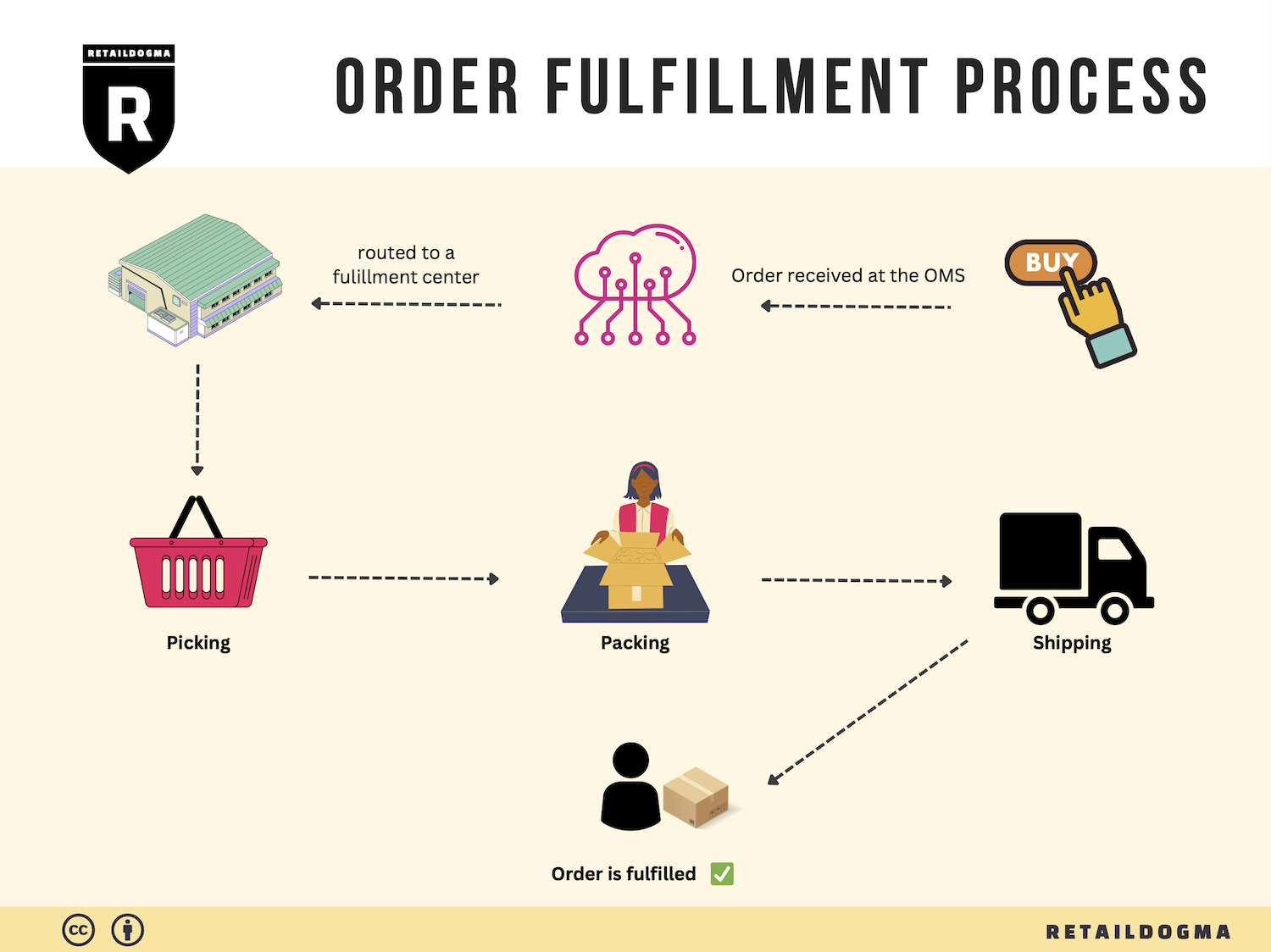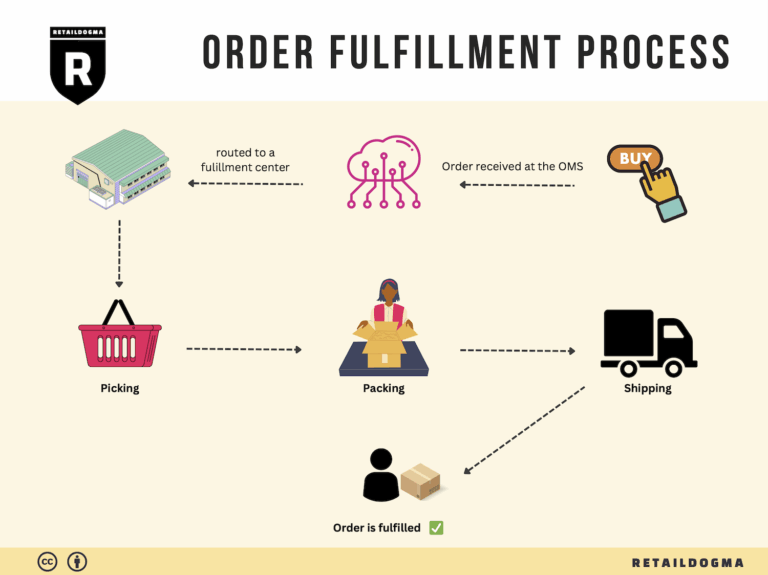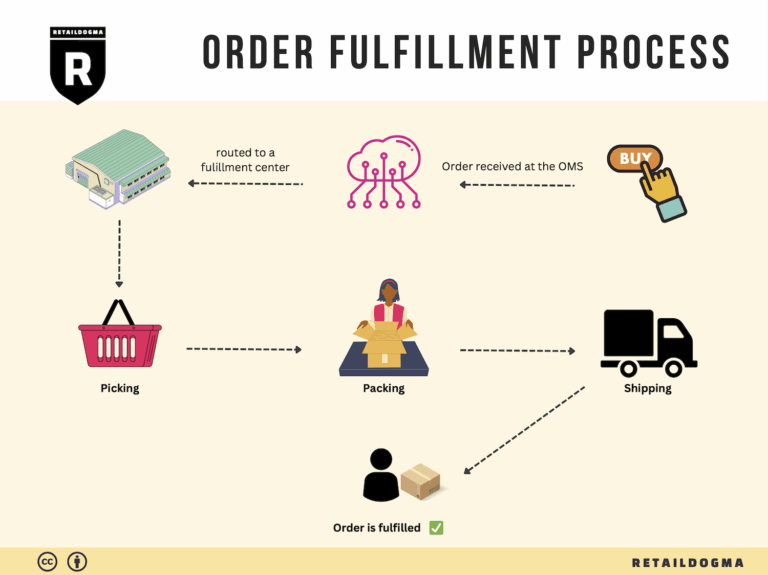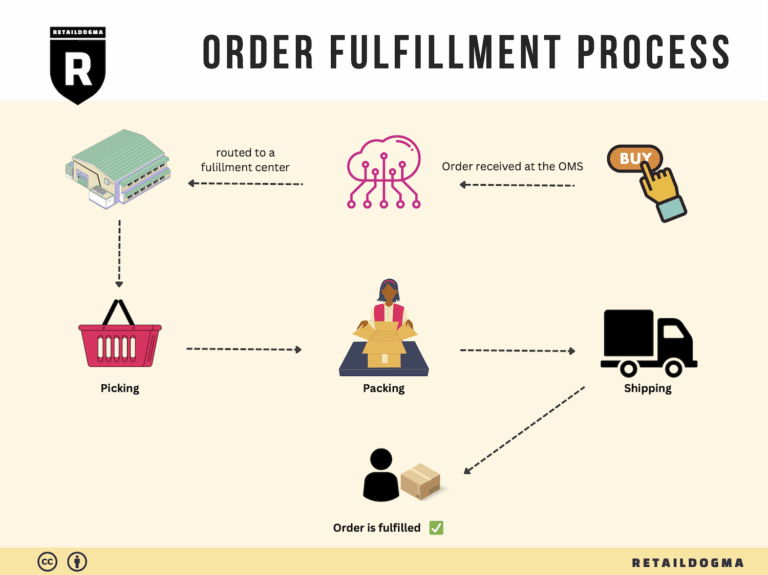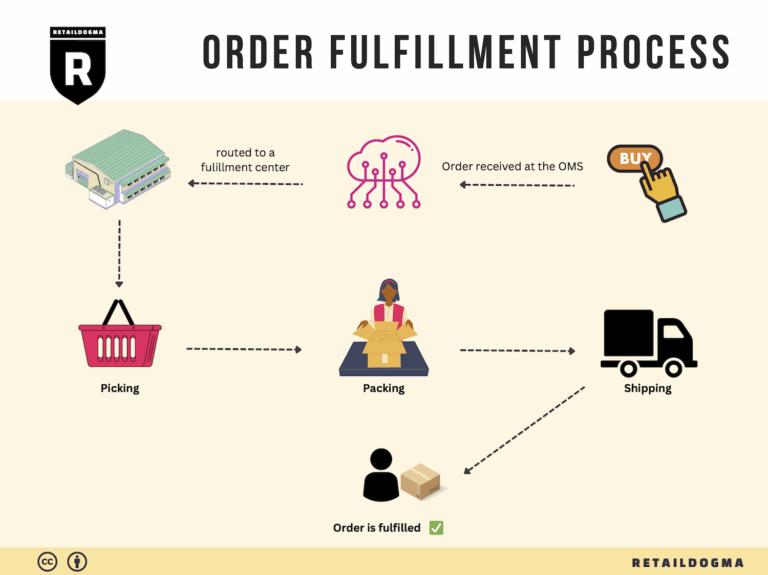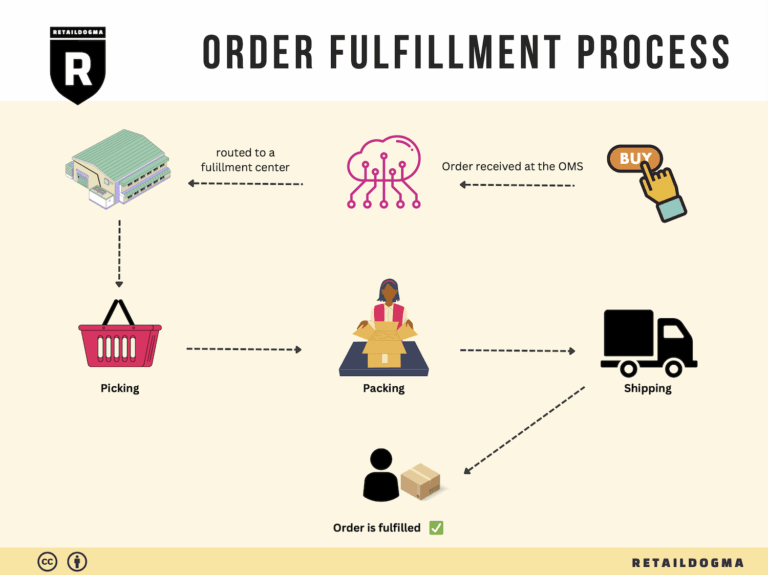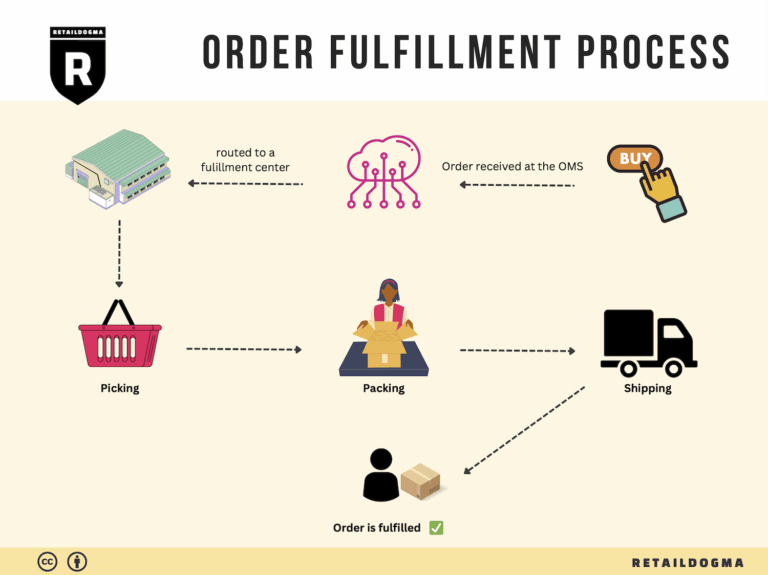What Is A Fulfillment Center? A Complete Guide (2025)
What is E-commerce Fulfillment? An Introduction for Growing Businesses
Understanding the Challenges of E-commerce Fulfillment
As your e-commerce business scales, the excitement of increasing sales can quickly turn into a daunting challenge: the overwhelming task of packing and shipping orders. For many entrepreneurs, the fulfillment process becomes a significant pain point, consuming time and resources that could be better spent on growth strategies and customer engagement. It’s crucial to understand that fulfillment is not just about sending products; it’s the entire process of getting a product into the hands of your customers, from order processing to delivery.
What is E-commerce Fulfillment?
E-commerce fulfillment refers to the systematic process of receiving, processing, and delivering customer orders. This includes everything from inventory management and order processing to packing, shipping, and handling returns. As businesses grow, the complexity of this process can increase, leading to potential pitfalls such as delayed shipments, inventory mismanagement, and ultimately, unhappy customers.
What This Guide Will Cover
In this comprehensive guide, we will explore the various fulfillment models available to e-commerce businesses, including Third-Party Logistics (3PL) and Fulfilled by Amazon (FBA). Each model has its own set of advantages and considerations, and understanding them is key to making an informed choice that aligns with your business goals.
We will also delve into the core services that fulfillment partners typically offer, such as inventory storage, order processing, packaging, and shipping. Additionally, we will discuss how to choose the right fulfillment partner based on your specific needs and operational requirements, including factors like location, technology, and customer service.
Finally, we will break down the pricing structures associated with different fulfillment options. Understanding the cost implications will empower you to make decisions that not only enhance your operational efficiency but also maintain your profit margins.
Goal of the Guide
The ultimate goal of this guide is to equip e-commerce business owners, operations managers, and entrepreneurs with the knowledge and tools necessary to navigate the complexities of fulfillment. By the end, you will be empowered to make strategic decisions about your logistics that can drive growth, improve customer satisfaction, and streamline your operations. Whether you’re just starting or looking to refine your existing processes, this guide will provide valuable insights to help you succeed in the competitive e-commerce landscape.
What You’ll Learn In This Guide
- What is E-commerce Fulfillment? An Introduction for Growing Businesses
- The Order Fulfillment Process: From ‘Buy’ Button to Customer’s Door
- Comparing Fulfillment Models: In-House vs. 3PL vs. Dropshipping
- A Deep Dive into Amazon FBA: Pros, Cons, and Who It’s For
- Core Services Offered by Fulfillment Centers
- How to Choose a Fulfillment Partner: A 6-Point Checklist
- Understanding Fulfillment Pricing: A Breakdown of Common Fees
- Frequently Asked Questions (FAQs) about Fulfillment
- Conclusion: Is Outsourcing Fulfillment the Right Move for Your Business?
- Important Disclaimer
The Order Fulfillment Process: From ‘Buy’ Button to Customer’s Door
1. Receiving Inventory
The order fulfillment process begins with receiving inventory, which is a critical step in ensuring that products are available for order fulfillment. Upon arrival at the fulfillment center, goods are unloaded and inspected for quality and quantity. This process often involves scanning each item using a barcode system, which allows for accurate tracking and inventory management.
The importance of this step cannot be overstated. Proper inventory management ensures that you have the right products available when customers place orders. If items are damaged or missing, it can lead to delays in fulfilling orders, negatively impacting customer satisfaction. A key term associated with this step is SKU (Stock Keeping Unit), a unique identifier assigned to each product that helps in tracking inventory levels and sales.
2. Warehouse Storage
Once inventory is received, the next step is warehouse storage. Products are organized and stored in designated areas within the fulfillment center. Efficient warehouse layout and storage solutions are essential to maximize space and facilitate quick retrieval of items. Products are often categorized by type, size, or sales velocity, which can significantly speed up the order picking process later on.
The significance of effective storage cannot be overlooked. A well-organized warehouse minimizes the time spent searching for items, reduces the risk of errors, and enhances overall operational efficiency. Implementing a Warehouse Management System (WMS) can help streamline this process by automating inventory tracking and optimizing storage locations based on real-time data.
3. Order Picking
Order picking is the process of retrieving items from storage to fulfill customer orders. This step involves generating pick lists, which are documents or digital notifications that outline the items and quantities needed for each order. Workers or automated systems then locate the items in the warehouse and prepare them for packing.

This stage is crucial because it directly affects the accuracy and speed of order fulfillment. Errors in picking can lead to incorrect shipments, resulting in customer dissatisfaction and increased return rates. To enhance the picking process, businesses can adopt various methods, such as batch picking (where multiple orders are picked simultaneously) or zone picking (where workers are assigned specific areas of the warehouse). Utilizing technology like RFID (Radio-Frequency Identification) can also improve accuracy and efficiency in this step.
4. Order Packing
After items are picked, they move to the order packing stage. Here, products are carefully packaged for shipment, ensuring they are protected during transit. This process often involves selecting appropriate packing materials, such as boxes, bubble wrap, or packing peanuts, based on the nature of the products.
The importance of packing cannot be overstated; effective packing minimizes the risk of damage during shipping and enhances the unboxing experience for customers. This stage also provides an opportunity for branding, as businesses can include promotional materials or branded packaging. A key term related to this step is packaging optimization, which focuses on using the right materials and sizes to reduce shipping costs and improve sustainability.
5. Shipping & Delivery
The final step in the order fulfillment process is shipping and delivery. Once orders are packed, they are labeled and prepared for shipment. This stage involves selecting shipping carriers, scheduling pickups, and tracking packages until they reach the customer’s doorstep.
Shipping is a pivotal aspect of customer satisfaction; timely and reliable delivery can significantly influence repeat business. Businesses should consider utilizing a Shipping Management System (SMS) to automate carrier selection, rate comparisons, and tracking notifications. Furthermore, offering multiple shipping options, such as standard, expedited, and same-day delivery, can cater to diverse customer needs and enhance their overall experience.
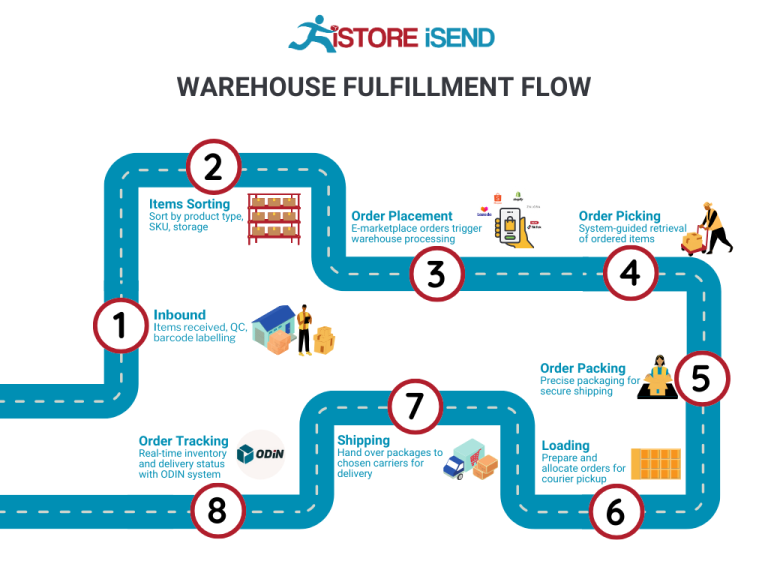
By understanding and optimizing each of these five steps—receiving inventory, warehouse storage, order picking, order packing, and shipping & delivery—e-commerce businesses can create a streamlined order fulfillment process that not only meets customer expectations but also drives operational efficiency and growth.
Comparing Fulfillment Models: In-House vs. 3PL vs. Dropshipping
Comparing Fulfillment Models: Overview
As e-commerce businesses grow, understanding the different fulfillment models is crucial for scaling operations effectively. Each model has its unique characteristics, advantages, and challenges. Below is a comparative overview of three prevalent fulfillment models: In-House Fulfillment, Third-Party Logistics (3PL), and Dropshipping.
| Model | Who Handles Inventory | Best For (Business Stage) | Key Advantage | Key Disadvantage |
|---|---|---|---|---|
| In-House Fulfillment | The business itself | Established businesses with stable demand | Greater control over inventory and fulfillment processes | High overhead costs and resource-intensive |
| Third-Party Logistics (3PL) | A third-party logistics provider | Growing businesses looking to scale | Cost-effective and scalable solutions | Less control over inventory and fulfillment speed |
| Dropshipping | Supplier or manufacturer | Startups and small businesses | Low upfront costs and no inventory risk | Lower profit margins and reliance on supplier reliability |
In-House Fulfillment
In-house fulfillment refers to managing the entire inventory and shipping process within the business itself. This model typically suits established e-commerce companies that have a stable demand for their products and can afford the investment in warehouse space, personnel, and technology.
Key Advantages: The primary advantage of in-house fulfillment is the level of control it provides. Businesses can directly manage inventory levels, shipping times, and customer service, allowing for a more personalized and responsive operation. This model also enables the company to implement specific quality control measures, ensuring that products meet the desired standards before they reach the customer.
Key Disadvantages: However, in-house fulfillment comes with significant overhead costs. Businesses must invest in warehousing, staff, and logistics infrastructure, which can be resource-intensive. Additionally, as demand fluctuates, maintaining a large inventory can lead to excess stock or stockouts, both of which can negatively impact cash flow and customer satisfaction.
Third-Party Logistics (3PL)
Third-party logistics (3PL) involves outsourcing logistics and fulfillment operations to an external provider. This model is particularly appealing to growing businesses that need to scale quickly without the burden of managing their own warehousing and distribution.
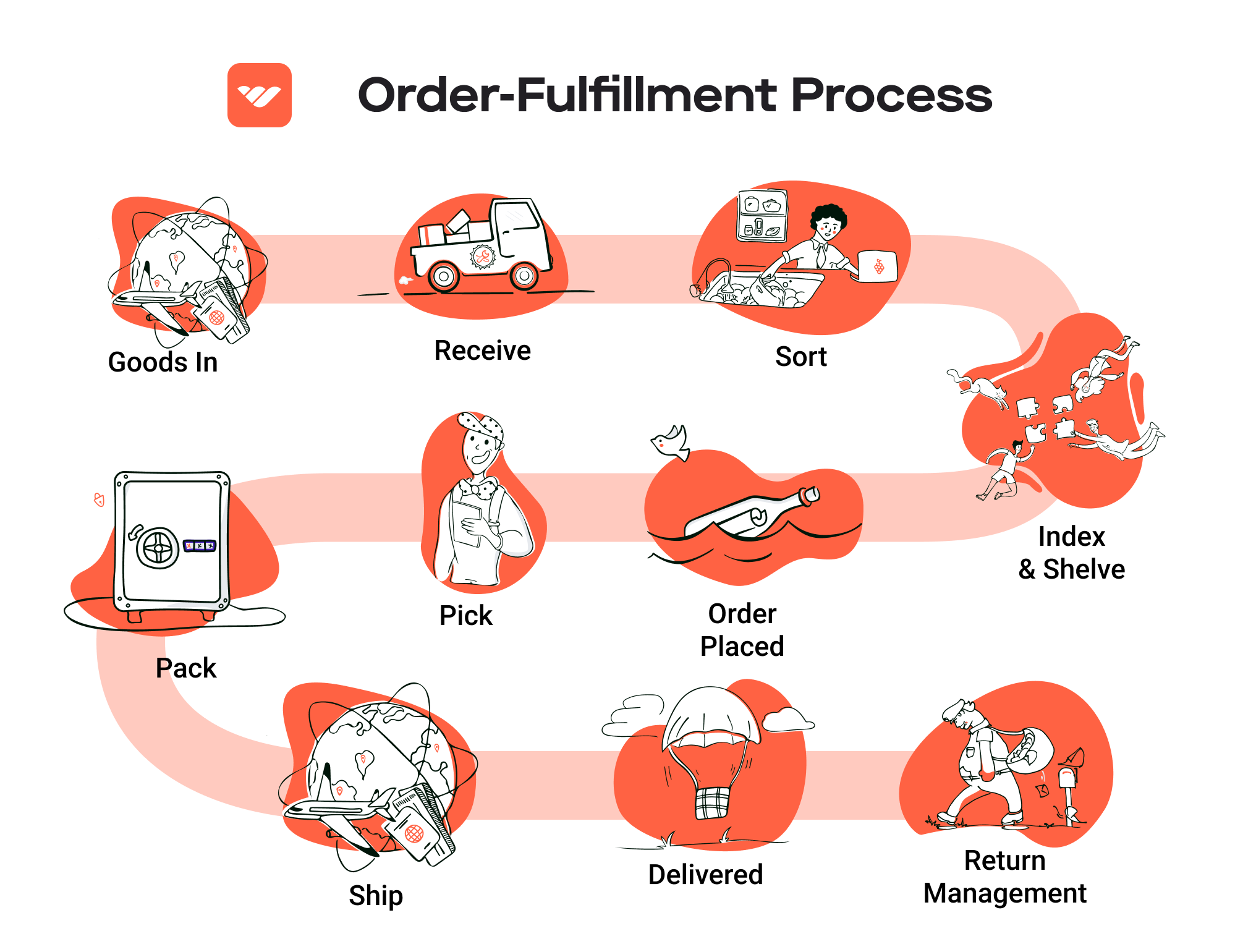
Key Advantages: The main benefit of using a 3PL is cost-effectiveness. By outsourcing logistics, businesses can leverage the infrastructure and expertise of the 3PL provider, which often leads to lower shipping rates and faster delivery times. Additionally, 3PL providers typically offer technology solutions that can streamline order processing and inventory management, further enhancing operational efficiency.
Key Disadvantages: The downside of 3PL is the potential loss of control over inventory and fulfillment processes. Businesses may face challenges in ensuring that their branding and quality standards are upheld by the 3PL provider. Furthermore, any delays or issues on the 3PL’s end can directly impact the business’s reputation and customer satisfaction.
Dropshipping
Dropshipping is a fulfillment model where the retailer does not keep products in stock. Instead, when a customer places an order, the retailer purchases the item from a third-party supplier, who then ships it directly to the customer. This model is ideal for startups and small businesses that want to minimize upfront investment.
Key Advantages: One of the most significant advantages of dropshipping is the low barrier to entry. Retailers can start selling products without the need to invest in inventory, making it a risk-averse option. This model allows entrepreneurs to test different products and niches without significant financial commitment, enabling them to adapt quickly to market demands.
Key Disadvantages: However, dropshipping often results in lower profit margins due to the reliance on suppliers for fulfillment. Moreover, retailers have less control over inventory levels and shipping times, which can lead to customer dissatisfaction if the supplier fails to deliver on time or if there are stock shortages. Additionally, the quality of customer service can suffer if the retailer is unable to resolve issues directly with the supplier.
Conclusion
Choosing the right fulfillment model is crucial for the success of an e-commerce business. Each model offers distinct advantages and challenges that must be weighed against the specific needs and goals of the business. Established businesses may benefit from the control of in-house fulfillment, while growing companies might find 3PL solutions more suitable for scaling operations. For startups, dropshipping provides a low-risk entry point into the e-commerce market. Ultimately, understanding these models will empower e-commerce business owners to make informed decisions that align with their growth strategies.
A Deep Dive into Amazon FBA: Pros, Cons, and Who It’s For
Understanding Fulfillment by Amazon (FBA)
Fulfillment by Amazon (FBA) is a service offered by Amazon that allows e-commerce sellers to store their products in Amazon’s fulfillment centers. Amazon takes care of storage, packaging, and shipping products to customers on behalf of the sellers. This service enables sellers to leverage Amazon’s extensive logistics network, ensuring that their products can be delivered quickly and efficiently.
How FBA Works
-
Setup: Sellers create an Amazon seller account and enroll in the FBA program. They list their products on Amazon and specify that they will use FBA for fulfillment.
-
Shipping Inventory: Sellers send their products to Amazon’s fulfillment centers. They can choose to send their entire inventory to one location or distribute it across multiple centers.
-
Storage: Once the products arrive at the fulfillment center, Amazon stores them until they are sold. Sellers are charged storage fees based on the amount of space their products occupy.
-
Order Fulfillment: When a customer places an order, Amazon picks, packs, and ships the product on behalf of the seller. This includes managing customer service and returns.
-
Payment: After the product is sold, Amazon deducts its fees and disburses the remaining amount to the seller.
Pros of FBA
-
Prime Eligibility: Products fulfilled by Amazon are eligible for Amazon Prime, which significantly increases visibility and sales potential. Prime members often prefer Prime-eligible items due to faster shipping options.
-
Customer Trust: Products sold through FBA benefit from Amazon’s trusted reputation. Customers are more likely to purchase from a seller using FBA, as they are assured of reliable shipping and customer service.
-
Multi-Channel Fulfillment: FBA allows sellers to fulfill orders from other sales channels (like eBay or their own websites) using Amazon’s logistics. This can streamline operations and provide a consistent customer experience across platforms.
-
Scalability: FBA can help businesses scale rapidly. Sellers can focus on marketing and product development while Amazon handles the logistics, making it easier to grow sales without the corresponding increase in operational complexity.
-
Advanced Logistics: Amazon’s advanced technology and logistics capabilities enable faster delivery times, which can enhance customer satisfaction and encourage repeat purchases.
Cons of FBA
-
High Fees: FBA involves various fees, including storage fees, fulfillment fees, and additional charges for long-term storage. These can add up quickly and impact profitability, especially for low-margin products.
-
Strict Inventory Rules: Amazon has stringent inventory management policies. Sellers must maintain sufficient stock levels to avoid stockouts, and they must also adhere to Amazon’s guidelines for packaging and labeling.
-
Commingling Risks: FBA products are commingled, meaning that sellers’ inventory may be mixed with that of other sellers. This can lead to issues with returns and quality control, as sellers may receive back their products that have been damaged or mixed with other sellers’ items.
-
Loss of Control: Sellers give up some control over the fulfillment process. Amazon’s policies dictate many aspects of the service, including shipping methods and customer interactions, which may not align with a seller’s brand or customer service philosophy.
-
Limited Customization: FBA does not allow for much customization in packaging or branding, which can be a disadvantage for sellers who want to provide a unique unboxing experience for their customers.
Who is FBA Best For?
Fulfillment by Amazon is an excellent option for various types of e-commerce businesses, particularly:
-
Small to Medium-Sized Sellers: Those who may not have the resources to manage their own logistics can benefit from FBA’s comprehensive services.
-
High-Demand Products: Sellers with popular products that can move quickly through Amazon’s marketplace can maximize profits despite the fees associated with FBA.
-
Sellers Focused on Growth: Businesses looking to scale rapidly can leverage FBA to handle logistics while they concentrate on marketing, product development, and other growth strategies.
-
Those Targeting Prime Customers: Sellers who want to reach Amazon’s vast Prime member base will find FBA crucial in making their products more appealing to these consumers.
-
Multi-Channel Sellers: Businesses selling on multiple platforms can utilize FBA for streamlined order fulfillment, helping to maintain consistent service levels across different sales channels.
In conclusion, while FBA offers numerous benefits, including access to a vast customer base and simplified logistics, it is essential for sellers to carefully consider the associated costs and operational implications. By understanding both the advantages and drawbacks, e-commerce businesses can make informed decisions about whether FBA aligns with their growth strategies and operational needs.
Core Services Offered by Fulfillment Centers
Inventory Management & Warehousing
Fulfillment centers offer comprehensive inventory management and warehousing solutions that are crucial for e-commerce businesses. This service involves the storage of products in a controlled environment, ensuring that inventory levels are accurately monitored and managed. Fulfillment centers utilize sophisticated inventory management systems that track stock levels in real-time, providing business owners with insights into their inventory turnover rates, stock levels, and forecasting needs.
The benefits of effective inventory management are manifold. By outsourcing this function to a fulfillment center, e-commerce businesses can avoid the pitfalls of overstocking or stockouts, which can lead to lost sales and increased holding costs. Fulfillment centers can also optimize space utilization, ensuring that products are stored in a manner that facilitates quick access and efficient order fulfillment. This operational efficiency translates into faster shipping times and improved customer satisfaction, which are critical in today’s competitive marketplace.
Pick and Pack Services
Pick and pack services are at the core of the fulfillment process. This service involves selecting items from the warehouse based on customer orders and packaging them for shipment. Fulfillment centers employ technology and automated systems to streamline this process, ensuring accuracy and speed. Staff members are trained to handle products carefully, reducing the risk of damage during the picking and packing process.
For e-commerce businesses, the advantages of pick and pack services are significant. First, they enhance order accuracy, which is essential for maintaining customer trust and satisfaction. A high level of accuracy in order fulfillment minimizes returns and improves customer loyalty. Additionally, fulfillment centers often implement batch picking, where multiple orders are processed simultaneously, further expediting the fulfillment process. This efficiency allows businesses to scale operations without compromising service quality, making it easier to handle peak seasons or sudden spikes in demand.
Kitting and Assembly
Kitting and assembly services offered by fulfillment centers are particularly beneficial for e-commerce businesses that sell products that require bundling or assembly before shipping. Kitting involves grouping together related items into a single package, while assembly refers to the process of putting together multiple components to create a final product. This can include anything from assembling furniture to packaging promotional kits.
The primary advantage of kitting and assembly services is the ability to provide customers with ready-to-use products. This is especially appealing in markets where convenience is a priority. By utilizing these services, e-commerce businesses can reduce the time customers spend on product assembly, enhancing the overall customer experience. Additionally, kitting can help in inventory management by consolidating multiple SKUs into a single product, simplifying the storage and shipping processes. This not only saves space but also reduces shipping costs, as fewer packages may need to be sent out.
Returns Management (Reverse Logistics)
Returns management, or reverse logistics, is a critical service that fulfillment centers provide to e-commerce businesses. This process involves handling product returns efficiently and effectively, ensuring that returned items are processed and restocked in a timely manner. Fulfillment centers implement robust systems for returns management, including tracking returned items, inspecting them for damage, and determining whether they can be restocked, repaired, or need to be discarded.
The benefits of effective returns management cannot be overstated. A seamless returns process enhances customer satisfaction and fosters brand loyalty, as customers are more likely to shop with businesses that offer hassle-free returns. Furthermore, efficient returns processing minimizes losses associated with returned merchandise and helps maintain accurate inventory levels. For e-commerce businesses, having a reliable returns management system is essential not only for financial health but also for building a positive brand reputation in a market where customer experience is paramount.
In conclusion, partnering with a fulfillment center for these core services can significantly enhance the operational capabilities of e-commerce businesses. By leveraging the expertise and technology of fulfillment centers, businesses can focus on growth and customer engagement while ensuring their logistics are handled with efficiency and precision. As the e-commerce landscape continues to evolve, investing in these services will be critical for staying competitive and meeting customer expectations.
How to Choose a Fulfillment Partner: A 6-Point Checklist
Location & Warehouse Network
Why It Matters:
The geographical location of your fulfillment partner’s warehouses plays a crucial role in shipping efficiency and costs. A partner with strategically located warehouses can help reduce shipping times and costs, which is vital for maintaining customer satisfaction in e-commerce.
Questions to Ask:
1. Where are your warehouses located, and how does that impact shipping times to my target markets?
2. Do you have a network of warehouses that can help me reach my customers faster?
3. Are there plans for expansion in locations that are significant for my business?
Technology & Integrations
Why It Matters:
In today’s digital age, technology is a game-changer in the logistics space. A fulfillment partner should have robust technology that allows for seamless integration with your e-commerce platforms. This ensures real-time inventory tracking, order processing, and data analytics.
Questions to Ask:
1. What fulfillment management software do you use, and how does it integrate with my existing systems?
2. Can your technology provide real-time updates on inventory levels and order statuses?
3. What reporting tools are available for analyzing shipping performance and inventory turnover?
Specializations (e.g., Cold Storage, Oversized Items)
Why It Matters:
Your product line may require specific handling or storage conditions. For instance, perishables need cold storage, while bulky items require specialized warehousing. Choosing a partner with the right specializations ensures your products are stored and shipped correctly.
Questions to Ask:
1. What types of specialized storage do you offer (e.g., cold storage, hazardous materials)?
2. Do you have experience handling products similar to mine?
3. What procedures do you have in place for quality control and compliance in specialized areas?
Scalability & Capacity
Why It Matters:
As your business grows, your fulfillment needs will evolve. A good fulfillment partner should be able to scale up operations to accommodate increasing order volumes without compromising service quality.
Questions to Ask:
1. How do you handle peak seasons or unexpected spikes in order volume?
2. What are your current capacity limits, and how quickly can you scale operations if needed?
3. Can you provide references from businesses of similar size and growth trajectory?
Pricing and Contracts
Why It Matters:
Understanding pricing structures and contract terms is essential for budgeting and financial forecasting. A transparent pricing model helps you avoid unexpected costs, and clear contract terms protect your interests.
Questions to Ask:
1. What is your pricing model (e.g., per order, per item, monthly fees)?
2. Are there any hidden fees, such as for storage, packaging, or returns?
3. What are the terms of the contract, and what is the process for contract termination?
Customer Support & Reviews
Why It Matters:
Reliable customer support is crucial when issues arise, whether they’re related to order fulfillment, inventory discrepancies, or customer service. Additionally, reviews and testimonials from other clients can provide insight into the partner’s reliability and performance.
Questions to Ask:
1. What kind of customer support do you offer (e.g., dedicated account manager, 24/7 support)?
2. Can you provide references or case studies from similar businesses?
3. How do you handle customer complaints and issues that arise during the fulfillment process?
Conclusion
Choosing the right fulfillment partner is a critical decision that can significantly impact your e-commerce business’s success. By using this checklist, you can ensure that you evaluate potential partners comprehensively, aligning their capabilities with your business needs. Take the time to ask the right questions and gather all necessary information, as this will help you make an informed decision that supports your growth ambitions.
Understanding Fulfillment Pricing: A Breakdown of Common Fees
Initial Setup Fees
When you begin using an Amazon fulfillment center, there may be initial setup fees involved. These fees typically cover the cost of onboarding your business into the fulfillment system. The setup process can include creating your seller account, integrating your inventory management system, and establishing your shipping preferences.
The calculation of initial setup fees can vary based on the complexity of your business and the services you require. For example, if you need specialized services such as kitting (assembling products into sets), additional fees may apply. It’s essential to discuss your specific needs with the fulfillment provider to understand the full scope of the setup costs.
Receiving Fees
Receiving fees are charged when the fulfillment center accepts your inventory. This fee covers the labor and resources required to unload, inspect, and store your goods.
Receiving fees are usually calculated on a per-unit basis, meaning you’ll pay a fee for each item delivered to the fulfillment center. The exact rate can depend on the size and weight of the items. For example, larger or bulkier items may incur higher receiving fees due to the additional handling required. It’s advisable to plan your shipments carefully and consolidate deliveries when possible to minimize these costs.
Storage Fees (per pallet/bin)
Storage fees apply to the space your inventory occupies within the fulfillment center. These fees are typically charged monthly and can vary based on the volume of space your products take up, measured in pallets or bins.
Most fulfillment centers offer tiered pricing structures based on the amount of space you use. For instance, you might pay a lower rate for the first few pallets and a higher rate once you exceed a certain threshold. Additionally, some centers charge different rates for standard and oversized items, so it’s crucial to understand how your products will be categorized. Keeping your inventory levels in check can help you manage storage fees effectively.
Pick & Pack Fees (per item/order)
Pick and pack fees are incurred each time an order is processed and shipped. This fee covers the cost of locating items in the warehouse, picking them for shipment, and packing them securely for delivery.
The calculation of pick and pack fees can vary based on the number of items in an order and the complexity of the packing process. For example, an order containing multiple items may incur a higher fee than a single-item order due to the increased labor involved. Some fulfillment centers also offer discounts for bulk orders or for businesses that consistently ship a high volume of products. Understanding the structure of these fees can help you optimize your order fulfillment process.
Shipping Fees
Shipping fees are one of the most significant costs in the fulfillment process, impacting your bottom line directly. These fees cover the costs of transporting your goods to customers and can vary widely based on factors such as the shipping method (standard, expedited, etc.), destination, and package size.
Shipping fees are typically calculated based on weight and dimensions, with many fulfillment centers using real-time carrier rates to determine the final shipping costs. Additionally, if you offer free shipping to customers, it’s crucial to factor these costs into your pricing strategy to maintain profitability. Regularly reviewing your shipping options and negotiating rates with carriers can lead to significant savings.
Tips for Getting an Accurate Quote
-
Be Transparent: Provide detailed information about your product types, sizes, weights, and anticipated order volumes when requesting a quote. This transparency helps fulfillment centers give you a more accurate estimate.
-
Understand Your Needs: Clearly outline your fulfillment requirements, including any special handling needs or additional services (like kitting or labeling) that may affect pricing.
-
Request a Breakdown: Ask for a detailed breakdown of all potential fees, including any variable costs. This will help you understand the full scope of your fulfillment expenses.
-
Compare Providers: Don’t hesitate to gather quotes from multiple fulfillment centers. Comparing different pricing models can help you identify the most cost-effective solution for your business.
-
Review Regularly: As your business grows and changes, regularly review your fulfillment needs and costs. This ensures you’re always getting the best possible rates and services for your operation.
By understanding these common fulfillment pricing models, you can better prepare your e-commerce business to scale effectively while managing costs.
Frequently Asked Questions (FAQs) about Fulfillment
1. What is the Amazon fulfillment center PVD2 in Johnston?
The Amazon fulfillment center PVD2, located in Johnston, Rhode Island, is a state-of-the-art facility designed to efficiently store, process, and ship products directly to customers. Opened in late 2025, this center employs over 1,500 full-time workers and utilizes advanced robotics and technology to enhance order fulfillment speed and accuracy.
2. How does the fulfillment process work at PVD2?
At PVD2, the fulfillment process begins when an order is placed by a customer. The center uses sophisticated inventory management systems to locate the ordered items. Robotics assist human workers in picking, packing, and shipping the items quickly. Once packed, the orders are sorted and sent out through various shipping options to reach customers in a timely manner.
3. What types of products are stored at the PVD2 facility?
The PVD2 fulfillment center houses a wide range of products, including electronics, household goods, clothing, and more. Amazon strategically selects inventory based on customer demand and trends, ensuring that popular items are readily available for quick shipping.
4. What is the difference between a warehouse and a fulfillment center?
A warehouse primarily focuses on storage, while a fulfillment center emphasizes the entire process of order fulfillment, including picking, packing, and shipping. Fulfillment centers are designed for speed and efficiency to meet customer demand, often integrating technology and logistics to streamline operations.
5. What is a 3PL (Third-Party Logistics)?
A 3PL, or third-party logistics provider, is a company that offers outsourced logistics services, including warehousing, transportation, and order fulfillment. Businesses often partner with 3PLs to leverage their expertise and resources, allowing them to focus on core operations while ensuring efficient order delivery.
6. How much do fulfillment services cost?
Fulfillment service costs can vary widely based on several factors, including the size of the business, volume of orders, and specific services required. Common pricing structures include per-order fees, storage fees, and shipping costs. Businesses should evaluate their needs and compare providers to find the most cost-effective solution.
7. What benefits does the PVD2 facility offer to e-commerce businesses?
The PVD2 fulfillment center provides numerous advantages, such as fast shipping times, access to Amazon’s extensive logistics network, and advanced technology for efficient order processing. This can enhance customer satisfaction and help businesses scale their operations without the need for significant investments in infrastructure.
8. Are there any job opportunities at the PVD2 fulfillment center?
Yes, the PVD2 facility offers numerous job opportunities, including positions in operations, management, and technology roles. Amazon emphasizes creating a diverse and skilled workforce, with programs in place to support employee education and career advancement.
9. How does Amazon ensure the quality of fulfillment services at PVD2?
Amazon employs rigorous quality control measures at its fulfillment centers, including regular audits, employee training programs, and the use of technology to minimize errors. These practices help maintain high standards for order accuracy and customer satisfaction.
10. Can small businesses benefit from using the PVD2 fulfillment center?
Absolutely. Small businesses can leverage the capabilities of the PVD2 fulfillment center to scale their operations without the burden of managing their own logistics. By utilizing Amazon’s infrastructure, small businesses can reach a wider audience, improve delivery times, and enhance their overall customer experience.
Conclusion: Is Outsourcing Fulfillment the Right Move for Your Business?
The Case for Outsourcing Fulfillment
Outsourcing fulfillment can be a transformative decision for e-commerce businesses looking to scale efficiently. By leveraging a fulfillment service, companies can save significant time and resources. This allows business owners to focus on core activities such as marketing, product development, and customer engagement, rather than getting bogged down in the complexities of logistics.
Another compelling advantage is scalability. As your sales volume fluctuates, a fulfillment partner can adapt to your needs without the challenges of hiring, training, or managing additional staff. This flexibility is crucial in today’s dynamic market, where consumer demand can shift rapidly.
Moreover, partnering with a fulfillment service brings specialized expertise into your operations. Experienced fulfillment centers, like the newly established PVD2 in Johnston, utilize advanced technology and a skilled workforce to ensure efficient order processing. This not only enhances the speed and accuracy of deliveries but also improves customer satisfaction—an essential factor in building a loyal customer base.
However, it is vital to choose the right fulfillment partner. Evaluate potential providers based on their capabilities, technology, geographical reach, and customer service. A well-aligned partner can help facilitate growth and support your unique business needs.
To determine if outsourcing fulfillment is the right next step for your business, conduct a thorough audit of your current shipping processes. Assess where inefficiencies lie and how a fulfillment partner could enhance your operations. This strategic evaluation will provide clarity on whether outsourcing is a viable option for your growth ambitions. Take the time to explore your options and make an informed decision that aligns with your business goals.
Important Disclaimer
⚠️ Important Disclaimer
The information in this guide is for educational purposes. Fulfillment services, pricing, and platform features change frequently. Always conduct your own due diligence and consult with providers directly before making business decisions.
